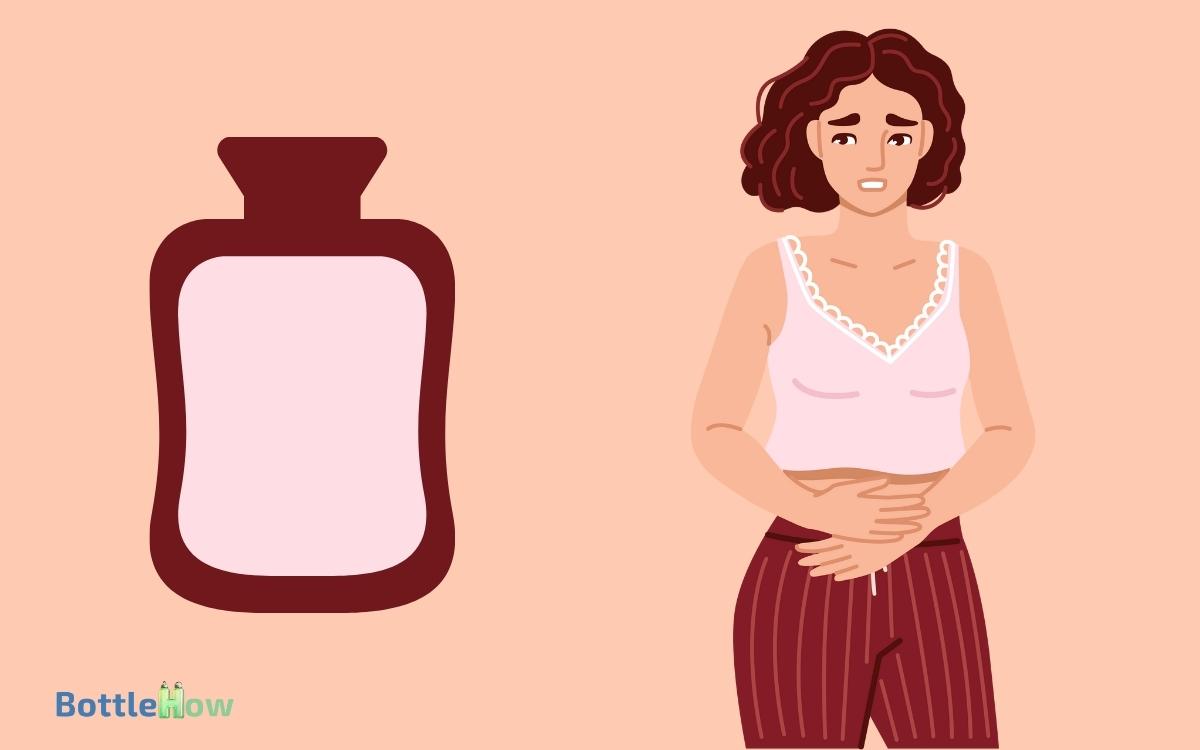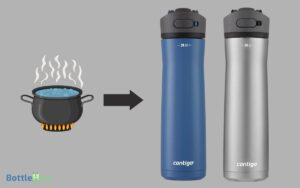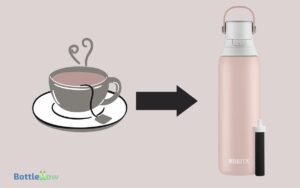Does a Hot Water Bottle Help Bloating? A Guide!
Using a hot water bottle can effectively alleviate bloating by relaxing your gastrointestinal tract muscles and enhancing blood flow.
The heat stimulates smooth muscle relaxation, reducing spasms and discomfort. It also increases circulation, which aids in gas and fluid movement, relieving abdominal pain.
Clinical evidence supports these therapeutic benefits, noting improved digestion and reduced visceral hypersensitivity.
For best results, apply the hot water bottle to your abdomen for 15-20 minutes. If you’re curious about additional ways to mitigate bloating, you’ll find several evidence-based approaches designed to ease this common gastrointestinal complaint.

Key Takeaways
Understanding Bloating
Bloating, a common gastrointestinal complaint, refers to the sensation of abdominal fullness or distension often accompanied by discomfort or pain.
When you experience bloating, your abdomen may feel thorough, swollen, and sometimes tender to the touch.
This condition can result from the accumulation of gas within the intestines or impaired movement of digestive contents.
Clinically, bloating is classified as either thorough or organic, depending on whether an underlying disease is present.
Effective management of bloating requires a complete understanding of your digestive health, dietary habits, and lifestyle factors.
Diagnostic approaches typically include a thorough medical history, physical examination, and sometimes, additional tests like imaging or endoscopy.
Recognizing the symptoms and patterns of your bloating is essential for appropriate treatment.
Causes of Bloating
You’ll find that bloating often stems from common dietary triggers such as high-fiber foods or lactose intolerance.
Gastrointestinal gas buildup due to swallowing air or bacterial fermentation in the gut can also contribute greatly.
Additionally, hormonal fluctuations, especially in females, can exacerbate bloating symptoms.
Common Dietary Triggers
Consuming foods high in fermentable sugars and fibers can greatly contribute to bloating and gastrointestinal discomfort. Understanding these dietary triggers helps you manage symptoms more effectively.
Certain foods contain components that aren’t fully absorbed in the small intestine, leading to fermentation by gut bacteria. This process produces gas, causing distension and discomfort.
Here are four common dietary triggers:
- FODMAPs: Fermentable oligosaccharides, disaccharides, monosaccharides, and polyols, found in foods like beans, lentils, and certain fruits.
- Cruciferous Vegetables: Broccoli, cauliflower, and cabbage contain raffinose, a sugar not easily digested.
- Carbonated Beverages: Soda and sparkling water introduce excess air into your digestive system.
- Fatty Foods: High-fat meals slow gastric emptying, increasing the feeling of fullness and bloating.
Gastrointestinal Gas Buildup
Several physiological processes contribute to gastrointestinal gas buildup, leading to bloating and discomfort. Aerophagia, or swallowing air, often occurs when you eat or drink too quickly.
Fermentation of undigested carbohydrates by gut bacteria can also result in gas production. Additionally, malabsorption syndromes like lactose intolerance can exacerbate gas accumulation. Understanding these mechanisms is essential for managing bloating effectively.
| Cause | Mechanism | Resulting Symptom |
|---|---|---|
| Aerophagia | Swallowing air during eating/drinking | Abdominal distension |
| Carbohydrate Fermentation | Gut bacteria fermenting undigested carbs | Excessive gas |
| Malabsorption Syndromes | Inability to digest certain foods | Increased bloating |
Hormonal Fluctuations Impact
Hormonal fluctuations, particularly those associated with the menstrual cycle, can greatly contribute to bloating by affecting fluid retention and gastrointestinal motility.
These changes may lead you to experience abdominal distension and discomfort. Understanding the mechanisms behind this can help manage symptoms effectively.
Here are key factors to take into account:
- Estrogen Levels: Elevated estrogen levels during the luteal phase can cause water retention.
- Progesterone Influence: Progesterone slows down gastrointestinal motility, leading to delayed bowel movements.
- Prostaglandins: Increased prostaglandin levels can induce gastrointestinal inflammation, exacerbating bloating.
- Dietary Sensitivity: Hormonal changes may heighten sensitivity to certain foods, contributing to bloating.
Heat Therapy Basics
Heat therapy, often referred to as thermotherapy, involves applying heat to specific body areas to alleviate pain and discomfort. You can use various methods, like hot water bottles, heating pads, or warm baths.
By increasing tissue temperature, heat therapy enhances blood flow, which can expedite healing processes and reduce muscle stiffness.
Clinical studies suggest that heat application can relax muscles and decrease pain signals sent to the brain.
It’s essential to apply heat for appropriate durations—typically 15 to 20 minutes—to avoid skin burns.
For safety, ensure the heat source isn’t too hot and use a protective layer, like a cloth, between your skin and the heat source.
Always consult a healthcare professional if you’re unsure about using heat therapy.
How Heat Helps
Applying heat to the abdominal area can alleviate bloating by relaxing the muscles and enhancing blood circulation.
When you apply heat, several physiological responses occur, which can directly combat the discomfort associated with bloating.
- Muscle Relaxation: Heat therapy promotes the relaxation of smooth muscles in the gastrointestinal tract, reducing spasms and cramps.
- Enhanced Blood Flow: Increased blood circulation helps deliver oxygen and nutrients to the area, facilitating quicker recovery and reducing inflammation.
- Nerve Signal Interruption: Heat can interfere with nerve transmission, diminishing the sensation of pain and discomfort.
- Stress Reduction: Applying heat can also trigger the release of endorphins, natural painkillers that reduce stress and discomfort.
Utilizing these mechanisms, you can effectively manage bloating symptoms with targeted heat application.
Hot Water Bottle Benefits
Have you ever considered how a hot water bottle might offer therapeutic benefits for alleviating bloating symptoms?
Applying localized heat can enhance blood circulation and promote muscle relaxation, which can mitigate discomfort and abdominal distension.
The warmth from the hot water bottle activates heat receptors, effectively blocking pain signals and reducing visceral hypersensitivity.
Additionally, heat application can stimulate the motility of the gastrointestinal tract, facilitating the passage of gas and reducing bloating.
Clinical studies have indicated that thermotherapy, such as using a hot water bottle, can provide immediate relief from gastrointestinal discomfort.
Proper Usage Tips
To maximize the therapeutic benefits of a hot water bottle for bloating, make sure that you fill it with water heated to a recommended temperature of 40-45°C (104-113°F) to prevent burns and achieve effective relief.
Follow these guidelines for best use:
- Use a cover: Always encase the hot water bottle in a cloth or special cover to avoid direct skin contact and potential burns.
- Check for leaks: Inspect the bottle for any leaks before use to guarantee safety and avoid water spillage.
- Limit application time: Apply the hot water bottle for 15-20 minutes at a time to prevent prolonged heat exposure, which can damage skin tissues.
- Position correctly: Place the hot water bottle on the abdominal area where bloating discomfort is most pronounced for targeted relief.
These steps will enhance the effectiveness and safety of your hot water bottle therapy.
Expert Opinions
You’ll find that the medical community often underscores the benefits of heat therapy for symptomatic relief of bloating.
Gastroenterologists typically recommend non-pharmacological interventions like a hot water bottle to reduce abdominal discomfort.
Additionally, alternative health experts support its use, citing improved blood circulation and muscle relaxation.
Medical Community Insights
Medical experts frequently assert that applying a hot water bottle to the abdomen can alleviate bloating by promoting muscle relaxation and enhancing blood flow.
Here’s how this simple remedy works:
- Muscle Relaxation: Heat helps relax the smooth muscles of the gastrointestinal tract, reducing spasms and discomfort.
- Enhanced Blood Flow: Increased circulation aids in the efficient movement of gas and fluids, which can relieve bloating.
- Pain Relief: The soothing warmth can diminish abdominal pain by interrupting the pain signal pathways.
- Stress Reduction: Heat application also activates the parasympathetic nervous system, reducing stress and its contribution to gastrointestinal symptoms.
Gastroenterologist Recommendations
Gastroenterologists often recommend using a hot water bottle as an effective, non-pharmacological approach to manage bloating and associated discomfort.
By applying localized heat, you can stimulate blood flow and relax the smooth muscles of the gastrointestinal tract. This action can alleviate cramping and facilitate the passage of gas, thereby reducing bloating.
Clinical evidence supports that heat therapy can positively impact visceral pain, making it a practical solution for many patients.
However, it’s important to wrap the hot water bottle in a cloth to prevent burns and maintain a comfortable temperature.
Always consult with your healthcare provider to verify that this method complements other treatments and doesn’t interfere with any underlying conditions you might have.
Alternative Health Perspectives
Many alternative health experts suggest that integrating heat therapy, such as using a hot water bottle, with other holistic practices can enhance its effectiveness in alleviating bloating and gastrointestinal discomfort.
You can combine heat therapy with several complementary approaches:
- Herbal Teas: Consuming chamomile or peppermint tea can provide antispasmodic and anti-inflammatory benefits.
- Probiotics: Taking probiotics can help balance gut flora, reducing bloating and improving digestion.
- Mindful Eating: Practicing mindful eating techniques can minimize overeating and air swallowing, which often contribute to bloating.
- Gentle Exercise: Engaging in activities like yoga or walking can stimulate digestive motility and alleviate gas build-up.
Scientific Studies
Several clinical studies have investigated the efficacy of hot water bottles in alleviating symptoms of bloating.
Research indicates that heat application can relax the abdominal muscles and improve blood flow, potentially reducing pain and discomfort associated with bloating.
For instance, thermotherapy has been shown to decrease visceral hypersensitivity, which is a common contributor to gastrointestinal distress.
Additionally, the warmth from a hot water bottle can stimulate peristalsis, aiding in the movement of gas and reducing the sensation of bloating.
However, while the evidence is promising, it’s crucial to remember that individual responses may vary.
Consulting with a healthcare professional is advisable to confirm that using a hot water bottle is an appropriate and safe remedy for your specific condition.
Comparing Remedies
When considering remedies for bloating, you should evaluate the benefits of herbal tea, the impact of dietary adjustments, and the effects of physical activity.
Clinical evidence suggests that herbal teas can aid digestion, while dietary changes can reduce symptom frequency.
Additionally, regular physical activity has been shown to improve gastrointestinal motility and alleviate bloating.
Herbal Tea Benefits
Comparing remedies for bloating, herbal teas like peppermint, ginger, and chamomile have demonstrated significant gastrointestinal benefits in clinical studies. They can alleviate bloating and enhance digestive function.
- Peppermint Tea: Contains menthol, which has antispasmodic properties that relax gastrointestinal muscles and reduce bloating.
- Ginger Tea: Rich in gingerol, it enhances gastric motility and accelerates gastric emptying, thereby reducing bloating.
- Chamomile Tea: Possesses anti-inflammatory and antispasmodic properties, which can soothe the digestive tract and mitigate bloating.
- Fennel Tea: Contains compounds like anethole that relax gastrointestinal muscles and alleviate gas and bloating.
You’ll find that incorporating these teas into your routine may provide a natural, evidence-based method to manage bloating effectively.
Dietary Adjustments Impact
Dietary adjustments can greatly impact bloating, with specific food choices either exacerbating or alleviating symptoms.
Consuming high-fiber foods like vegetables, fruits, and whole grains promotes digestive health and reduces bloating.
Conversely, foods high in FODMAPs—fermentable oligosaccharides, disaccharides, monosaccharides, and polyols—can worsen bloating by increasing gas production in the intestines.
You should also avoid carbonated beverages and artificial sweeteners, as they can introduce excess air and disrupt gut flora balance.
Probiotics, found in yogurt and fermented foods, can enhance gut microbiota and improve bloating symptoms.
Staying hydrated by drinking plenty of water aids digestion and prevents constipation, a common bloating cause. Making these dietary modifications can yield significant symptomatic relief.
Physical Activity Effects
Engaging in regular physical activity can greatly alleviate bloating by promoting efficient digestive motility and reducing gas accumulation in the intestines.
Exercise-induced peristalsis enhances the passage of food through the gastrointestinal tract, minimizing the chances of stagnation and fermentation, which often cause bloating.
Physical activity also stimulates the release of endorphins, which help in managing stress, a known contributor to gastrointestinal discomfort.
Consider incorporating the following activities into your routine:
- Brisk walking: Increases heart rate and stimulates bowel movements.
- Yoga: Specific poses can massage internal organs and improve digestion.
- Cycling: Moderate-intensity cycling aids in overall gut health.
- Core strengthening exercises: Enhances abdominal muscle tone, supporting digestive organs.
User Experiences
Many individuals report that applying a hot water bottle to the abdominal area can alleviate bloating and discomfort. Users frequently describe a reduction in pain and an overall sense of relief. The warmth helps to relax muscles and improve blood circulation, which may contribute to the soothing effect. Some people find that using a hot water bottle for diverticulitis discomfort provides temporary relief from cramps and tenderness. While it is not a cure, this simple remedy is often used alongside other treatments to manage symptoms.
This warmth can facilitate muscle relaxation and improve localized blood flow, potentially easing gastrointestinal tension.
| User Experience | Outcome Description |
|---|---|
| Pain Reduction | Significant decrease in abdominal pain |
| Muscle Relaxation | Noticeable relaxation of stomach muscles |
| Improved Circulation | Enhanced blood flow in the abdominal area |
| General Comfort | Overall feeling of relief and comfort |
Safety Considerations
When using a hot water bottle for bloating relief, it’s important to weigh the potential risks to guarantee safe and effective application.
Improper usage can lead to adverse effects, so consider these essential guidelines:
- Temperature Control: Make sure the water temperature is warm, not scalding, to prevent burns.
- Duration: Limit application to 20 minutes at a time to avoid skin irritation.
- Barrier Protection: Always use a cover or cloth to insulate the bottle, reducing direct heat exposure.
- Inspection: Regularly check the bottle for leaks or wear to avoid accidental burns.
Conclusion
To sum up, utilizing a hot water bottle can effectively alleviate bloating by relaxing your abdominal muscles and improving blood flow. But is it the ultimate remedy for everyone?
While scientific studies support its use, individual experiences may vary. Always consult your healthcare provider for personalized advice.
Remember, safety is paramount—don’t apply excessive heat or use it for prolonged periods. Combining this with other evidence-based therapies might offer you the most thorough relief.






